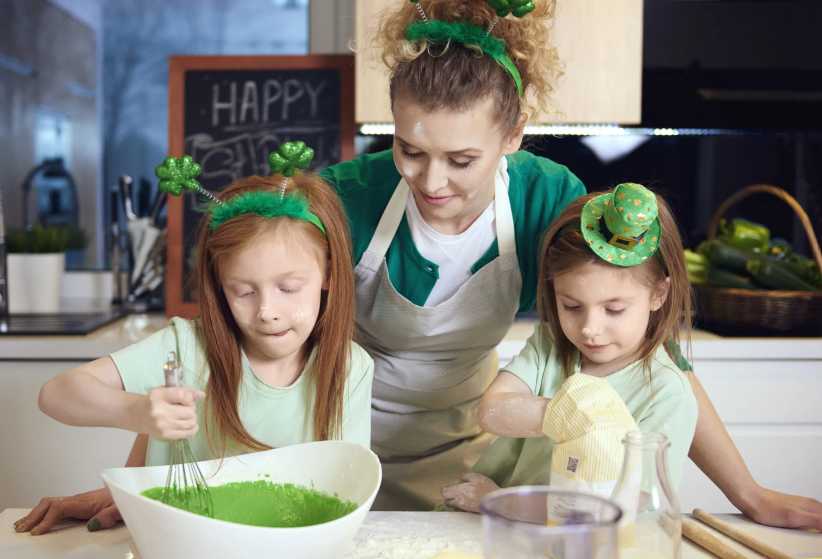Celebrating the bounty of fall produce at gatherings with family and friends is a true joy of the season. We all have our traditions and tried-and-true recipes. I am always looking for a few ways to tweak traditional recipes, with spices, flavors, and cooking techniques. I am also always looking for ways to get everyone, young and old, involved in creating a meal to share. I cherish the time spent with the people I love while we’re cooking. A little planning and some setup makes this time together a true joy. Here are a few tips on updating some classic recipes and ways to get everyone in the kitchen:
Family time preparing Brussels sprouts
Brussels sprouts have been in the spotlight for some years now. Chefs and home cooks have been sharing tons of recipes and techniques for preparing this beautiful vegetable. You can caramelize them with some pancetta; separate the leaves and create stir fry with ginger, soy, garlic and chili peppers; or simply roast them with some red onion slices and balsamic vinegar. Buy a whole stalk at the farmers’ market and have the kids pop off the little sprouts at the top.
Let the bigger kids use paring knives to cut the sprouts in half while the little ones separate the leaves for frying or adding to a salad. Buying the whole stalk at once may be a lot of work, but if you split it up, it can be a fun family activity.
Spice up your sweet potato
For family gatherings, I like to take classic family recipes and spice them up a bit. I take the basic potato gratin recipe and do a chipotle sweet potato gratin instead. (See the recipe below.)
You can scrape the seeds out of the chili to make it less spicy, and the smoky flavor is excellent with the earthy sweet flavor of the potatoes. This recipe can comes together quickly and can be made up to two days ahead, making it a great dish to travel with. Just re-heat in the oven and serve.
Try braising turkey legs
One problem many cooks encounter on Thanksgiving is fully cooked turkey breasts, but underdone legs. One easy way to solve that is to pull the legs off and continue to roast in the oven. For an interesting twist, however, you can try braising the legs.
When the breast is done (internal temperature of 165-degrees Fahrenheit at the thickest part), remove the legs from the breast. Let the breast rest under a foil tent. Set the roasting pan over a flame on the stovetop. Add some white wine (about a cup), three cups of turkey or chicken stock, a bay leaf, a spring of thyme, one shallot, two garlic cloves, and the juice of half a lemon. Let this liquid come to a boil, then reduce heat until it simmers. Scrape the bottom of the pan to release the cooked bits that are there from the roasting process.
Nestle the partially cooked legs into this simmering liquid. The legs should not be submerged, liquid should just go about half way up the legs.
Cover the roasting pan with foil and allow the legs to braise in the oven for about 30 to 40 minutes at 300 to 350-degrees Fahrenheit. Remove the legs to a platter, strain the cooking liquid and taste for seasoning. You can reduce the liquid further for a delicious turkey jus.
Use up all of those apples
Homemade applesauce is a great thing to have on hand. Kids love apple sauce as is, but it is also a great thing to have on hand for baking. Substitute applesauce for butter in cookies, muffins, brownies, and sweet quick breads. Try your favorite recipes with half the butter or oil replaced with applesauce.
At Léman Manhattan Preparatory School, we make chocolate-chip cookies with applesauce and the kids love them! You can even make a big batch of applesauce and freeze it in pint-size containers.
Try your root veggies raw
It’s so easy and comforting to crank up the oven and roast root vegetables on sheet trays. Sometimes, however, a crunchy raw root vegetable salad can be the perfect counterpoint to a meal of braised meat or Thanksgiving turkey dinner. I use a peeler and a cheese grater to create these delicious salads.
Parsnips, carrots, beets, celery root, and fennel (not a root veggie but delicious raw!) all make great salads. The key is to use a flavorful dressing and to add texture. Chopped nuts, scallions, fresh herbs, toasted ground spices, citrus zest, chili peppers, acid (such as vinegar or lemon juice), and fat (oil, mayonaise, yogurt) in the right combination will produce a fresh salad to liven up an otherwise heavy fall meal.
And if you want to involve the kids, let them pick the herbs, grate the vegetables on the cheese grater, or even help you in toasting and grinding your own spices.
Joanna DeVita is the executive chef at Léman Manhattan Preparatory School and a mother of two who loves sharing her love and respect for nature, good ingredients, and the joy of cooking with her family.
Sweet potato and chipotle gratin
INGREDIENTS
3 lb. sweet potatoes, peeled and thinly sliced
8 ounces aged white cheddar cheese, shredded
1 pint heavy cream
Salt and pepper to taste
3 pieces canned chipotle peppers in adobo, split with seeds scraped out, sliced thinly
2 tablespoons adobo sauce from the chipotle peppers
3 tablespoons butter
DIRECTIONS: Preheat oven to 325-degrees Fahrenheit. In a casserole dish or gratin dish, butter the bottom and sides, reserving two tablespoons of butter for later. Layer in the sweet potatoes, seasoning each layer with salt, pepper, and a sprinkling of cheddar cheese. Bring cream, chipotle peppers, and adobo sauce to a boil in a small sauce pan. Once boiling, turn off the heat. Pour hot cream mixture over layered potatoes. Place small pats of butter and a last sprinkling of cheese on the top of the gratin. Cover and bake for 45 minutes. Remove foil and bake until gratin is brown on top and bubbling, and the potatoes are cooked through.
Let cool slightly to set up the gratin. Enjoy!






















